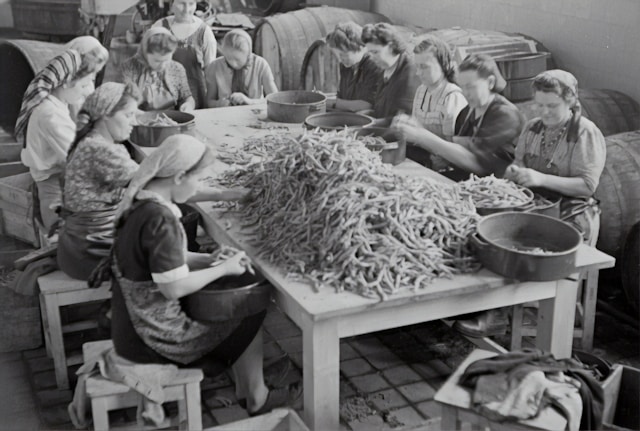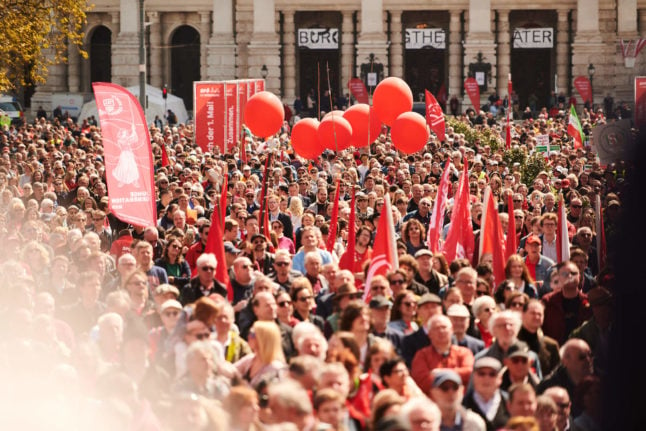The Day of Labour is a nationwide public holiday which celebrates and highlights the history of labour struggles and protests.
The movement for workers’ rights traces back to the US in the 19th century when conditions for factory workers were very poor and dangerous to their health. The poor conditions motivated the workers to gather and start fighting for improvement. This movement spread worldwide and reached Austria in 1886.
Nowadays, the 1st of May stands as a symbol of workers’ solidarity and serves as a reminder of the ongoing fight for fair labour practices and social justice. It honours the achievements of workers and the labour movement.

What is happening in Austria on this day?
In Austria, most people do not have to go to work or school as this is a bank holiday. In Vienna, just like in many other Austrian cities and towns, the Social Democratic Party (SPÖ) arranged Labour Day rallies to celebrate the occasion. In the capital, they gather at the town hall, Rathausplatz, to celebrate the day and promote their agenda for workers’ rights and social justice through speeches, presentations, and debates.
In most cities and towns, parades, demonstrations, and various events are being organised. In Salzburg, a parade under the motto “We walk together for peace” takes place, starting at 12 am at Residenzplatz, accompanied by music from live singers. In Graz, SPÖ arranged a parade starting from their pavilion at 08:45 am, and ending at the city’s main square, Hauptplatz. In Innsbruck, the SPÖ organises a celebration event at Rapoldipark starting at 11 am.
In general, May 1st offers a great variety of activities, no matter where in Austria you are. If you feel more like spending time in nature, a wide range of group outdoor activities are offered in different regions. For example, in Klagenfurt, you can participate in a family cycling event in the countryside. And if you are in Vorarlberg and in the mood for a market, you can visit the handicraft market, called “Wälder Markt”, with over 70 exhibitors presenting their handicrafts in the municipality of Hittisau in Vorarlberg, where you can also enjoy some snacks and drinks.
Maypole traditions
In addition, the maypole (Maibaum in German) is celebrated in different villages, which is one of the most important traditions happening on this day—though not connected to Labour Day but to the general start of the month of May (and the start of a nicer weather season).
The maypole celebration is a long-standing Austrian tradition where the locals of a village raise a maypole on the village square on May 1st as a symbol of fertility.
Maypole climbing, stealing the maypole, dancing around the pole, or maypole parades with brass bands are common traditions in most regions of Austria. The Maypole celebration is a very popular traditional event which strengthens the community spirit.
READ ALSO: Which days off will workers in Austria get in 2024?
What will be closed?
Since May 1st is a public holiday in Austria, banks, post offices, supermarkets, and general medical practices will be closed. Most pharmacies will also be closed, except for those functioning as emergency pharmacies, which are scheduled to remain open during the holidays. In Austria, around 220 pharmacies function as “Notdienstapotheken” or emergency pharmacies. Find them listed here.
Hospital emergency departments will remain open if you need medical care. Additionally, each region offers a holiday on-call service (Wochenend—und Feiertagsbereitschaftsdienst) if you prefer not to go to the hospital. You can call 141 for medical services during holidays, such as a doctor’s visit or to obtain certain medications.
Public Transport
On May 1st, public transport operates all over Austria, although sometimes with a reduced timetable, similar to that on Sundays.
In Vienna, trams, metros, and buses run with slightly reduced timetables. For information on the timetable for different lines, click here.
Mainline train services often run with a near-normal timetable during May 1st. You can check out the timetable for ÖBB here.



 Please whitelist us to continue reading.
Please whitelist us to continue reading.
Member comments